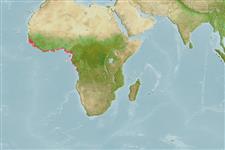กลุ่มปลาที่มีครีบคู่ แผ่แบนออกได้ลักษณะคล้ายพัด >
Clupeiformes (Herrings) >
Clupeidae (Herrings, shads, sardines, menhadens) > Dorosomatinae
Etymology: Ethmalosa: Greek, ethmos, -ou = sieve, also the ethmoides bone + Latin, alausa = a fish cited by Ausonius and Latin, halec = pickle, dealing with the Greek word hals = salt; it is also the old Saxon name for shad = "alli" ; 1591 (Ref. 45335).
ภาวะแวดล้อม / สภาพภูมิอากาศ / พิสัย
นิเวศวิทยา
; เกี่ยวกับทะเล,น้ำเค็ม; น้ำจืด; กร่อย; ปลาที่อพยพจากแหล่งน้ำจืดไปวางไข่ในน้ำเค็ม (Ref. 51243); ระดับความลึก 0 - ? m (Ref. 54436), usually 0 - 50 m (Ref. 54436). Tropical, preferred 27°C (Ref. 107945); 25°N - 8°S, 17°W - 14°E (Ref. 54436)
Atlantic Ocean: Eastern central Atlantic Ocean from Dakhla in Western Sahara to Lobito Bay in Angola (Ref. 188, 81269, 81631). Reports from Cape Verde Islands are based on an erroneous type locality for Clupea fimbriata by Bowdich (1825) which was followed by later authors (Ref. 188).
Length at first maturity / ขนาด / น้ำหนัก / Age
Maturity: Lm 17.0 range ? - 18.5 cm
Max length : 45.0 cm TL เพศผู้/กระเทย; (Ref. 5377); common length : 25.0 cm TL เพศผู้/กระเทย; (Ref. 26999)
เงี่ยงครีบหลัง (รวม): 0; ก้านครีบอ่อนที่หาง (รวม): 16-19; เงี่ยงครีบก้น 0; ก้านครีบอ่อนที่ก้น: 19 - 23. Diagnosis: Ethmalosa fimbriata is distinguished from other clupeids by the presence of a median notch on the upper jaw, into which tip of lower jaw fits (Ref. 188, 81269). A faint dark spot behind gill cover, sometimes followed by others; dorsal fin tip black; caudal fin deep chrome yellow; golden tints on body (Ref. 188). Ethmalosa fimbriata resembles Sardinella aurita, Sardinella rouxi and especially Sardinella maderensis, but these are more slender, have a rounded upper jaw which is not notched and the upper gillrakers are not bent upward like an elbow (Ref. 188).
Ethmalosa fimbriata is found in coastal and estuarine regions, and sometimes also in lower courses of coastal rivers, even more than 300 km up rivers (Ref. 188, 81269, 81631). It feeds by filtering phytoplankton, chiefly diatoms (Ref. 188). It breeds throughout the year in waters of salinities 3.5-38 ppt, but with peaks in at least some areas; spawns in the sea, in estuaries and in rivers (Ref. 188).
Breeds all year in waters of salinities 3.5 to 38 ppt, but with peaks in at least some areas, becoming progressively later to south. Spawns in the sea, in estuaries and in rivers.
Whitehead, P.J.P., 1985. FAO Species Catalogue. Vol. 7. Clupeoid fishes of the world (suborder Clupeioidei). An annotated and illustrated catalogue of the herrings, sardines, pilchards, sprats, shads, anchovies and wolf-herrings. FAO Fish. Synop. 125(7/1):1-303. Rome: FAO. (Ref. 188)
IUCN Red List Status (Ref. 115185)
CITES (Ref. 94142)
Not Evaluated
Threat to humans
Harmless
Human uses
การประมง: เน้นการพาณิชย์; การเพาะเลี้ยงสัตว์น้ำ: การทดลอง
ข้อมูลเพิ่มเติม
อ้างอิงการเพาะเลี้ยงสัตว์น้ำประวัติการเพาะเลี้ยงสัตว์น้ำสายพันธุ์พันธุศาสตร์ความถี่ของคู่ยีนอัตราพันธุกรรมโรคการแปรรูปMass conversion
ผู้ร่วมมือรูปภาพหลายรูปStamps, Coinsเสียงปลามีพิษ เช่น ปลาปักเป้าความเร็วรูปแบบการว่ายน้ำพื้นที่เหงือกOtolithsสมองวิสัยทัศน์
เครื่องมือ
Special reports
Download XML
แหล่งที่มาจากอินเตอร์เน็ต
